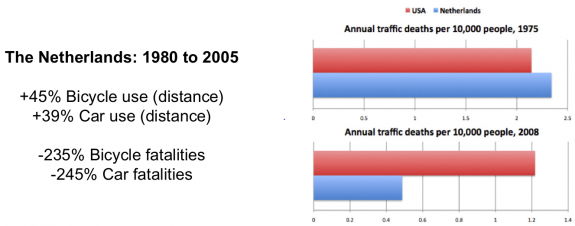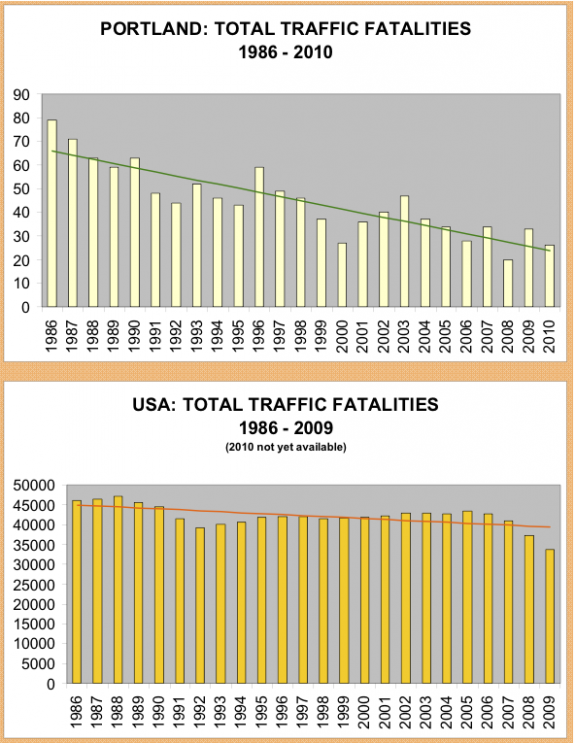If you didn’t make it to last week’s neighborhood greenways presentation and discussion with Portland’s Greg Raisman and Mark Lear, you’re in luck! University Greenways caught the whole thing on video (Mark and Greg’s talk gets going around the 8:00 mark).
The whole meeting was exciting and empowering, but particularly the first portion of Greg and Mark’s presentation is useful to everyone trying to figure out how to create a coalition for neighborhood greenways that stretches beyond people who ride bicycles.
Of everything I saw during the presentation, here’s the graph that grabbed me the most:
 This is stunning stuff, and it should be inspiring to everyone regardless of how they choose to get around town. We know how to make our roads safer for everyone, we just need to make the decision that protecting the lives of all people is our highest transportation priority.
This is stunning stuff, and it should be inspiring to everyone regardless of how they choose to get around town. We know how to make our roads safer for everyone, we just need to make the decision that protecting the lives of all people is our highest transportation priority.
Another important note about neighborhood greenways is that it has more in common with neighborhood traffic calming (which Seattle already does a lot of) than it does with bicycling. They are certainly great for bicycling, but perhaps SDOT should be looking to change the way we address neighborhood traffic calming and focus those efforts into greenways instead of expensive and only partially successful efforts, such as traffic circles. For example, we should probably be doing more (bike safe) speed bumps instead.
The city gets a remarkable number of requests for increased traffic calming on residential streets because nobody wants people speeding down streets in front of their homes where they, their kids and their pets walk, drive, bicycle and play. Combining traffic calming with new safe arterial crossings (the most expensive part of a neighborhood greenway), you get a neighborhood traffic calming project that does as much for people trying to walk or get to a bus stop across a busy street in the neighborhood as it does for people biking.
Clearly, people who bike and bicycle advocates are going to be a driving force behind neighborhood greenways. But the appeal of these projects reaches far beyond people who want safer streets for use as bicycle routes. They are about neighborhood life and safe communities.
Luckily, groups like Spokespeople, Beacon BIKES, Ballard Greenways, University Greenways and a growing list of other groups are already reaching out to district and community councils to introduce themselves and the idea of neighborhood greenways to people who live in those neighborhoods. Once people in Seattle learn what a neighborhood greenway is and start imagining what it would be like to live on or within a couple blocks of one, the momentum behind Seattle’s neighborhood greenways movement will really take off.
The SunBreak has more analysis of the presentation, including praise for Seattle councilmember Sally Bagshaw’s commitment to making neighborhood greenways a reality:
Portland Greenwayboosters Greg Raisman and Mark Lear were in Seattle recently to introduce the curious to this less-contentious form of transportation infrastructure. Seattle City Council’s Sally Bagshaw told the 70 people packed into the event that the time for greenways is now:
What I want to do–and as a member of your city council, what I am pledging to do–is to make sure that these neighborhood greenways become as real as what Portland has done. It is really my goal for my next few years while I am on the council.









Comments
12 responses to “Tuesday afternoon theater: An inspiring neighborhood greenways presentation”
The Dutch cut traffic fatalities by 245%. Even JC himself only raised one from the dead.
Math isn’t the bicyclists’ strength. Their enthusiasm is infectious, but not their logic.
I hope that either you’re not serious or you’re not really a teacher. If you’re serious, you may find this information useful: http://en.wikipedia.org/wiki/Percentage#Percentage_increase_and_decrease. If you’re really a teacher, your students may find that information useful.
Read your own link. You cannot cut anything by more than 100%. Were you staring out the window during arithmetic class?
Tom-
What do you mean by “only partially successful” in regards to Seattle’s traffic circle program? This program has reduced collisions at residential intersections by leaps and bounds since it was created in the late 70’s or early 80’s. An additional benefit is that the circles often slow down traffic. Not trying to be a troll, but I am curious what your meaning was.
That point definitely could have used some fleshing out. I like traffic calming, and the circles are effective at many of the goals of traffic calming. But Portland has found speed bumps to be their most effective tool. And traffic circles are not all that great for bicycling. They are good because they slow traffic, but they also create pinch points and are highly dependent on people using them correctly. You ever approach a circle to have someone else take a left the wrong way? Pretty scary and dangerous. Given the city has had these circles for this long and people still go the wrong way around them makes me feel like maybe there are other tools that take less of a learning curve.
Plus, when creating streets that are safe for children to use (neighborhood greenways should be safe for people as young as 8), we should design them so they can make small mistakes and it would be ok.
In talking with Greg Raisman, he suggested we increase sight lines at many of our traffic circles to make sure anyone approaching the circle can see approaching traffic in other directions. This would likely mean pushing parked cars back from the corner. That would also work.
I have been nearly struck a couple times from cars turning the wrong way on traffic circles, so I don’t really love them. Considering that they are pretty expensive, we could probably calm more traffic for the same money using other means.
But I don’t know. Maybe the circles are really good on hills or something. I would love to see info on that. Maybe we would determine they are the best tool in certain situations. But if we are just doing them because that’s what we always do, we should look into diversifying to get the best (or least… heh) bang for our buck.
Denver @ PBOT told me that Portland is actually no longer building traffic circles anymore because of complaints from bicyclists that cars tend to try to pass bicyclists unsafely when using the circles. (paraphrasing from memory – may be a bit off.)
If you’re really curious I could put you in touch with him to confirm.
Topes! Slows the cars down, or generates money for the local economy as the aggressive drivers have their ride towed and repaired.
Thanks, Tom! That clears it up.
I agree that there are things we can do to improve the circles. Sight distances have always been an issue but that is likely because these circles are being maintained by residents and not the city once they’re constructed. I also like the idea of moving back parking. But interestingly enough, when we increase the sight distances there is a tradeoff in that drivers go faster.
Argh! It’s a never ending cycle that we seem to get ourselves wrapped into. :)
Is there better data on the first two graphs? I don’t see how you can make any conclusive statements from the data as the scales are so different. Is there info on a percentage drop in fatalities in Portland vs. the US?
Although now that I look at it a bit more you can see that the percentage drop in Portland is way more than across the U.S.
Vancouver has some interesting greenways in the downtown core that are effective. Don’t have statistics re fatalities, but nice to see large city take those steps. They could use a few more bike friendly lanes outside the city center on some of the longer stretches of road.